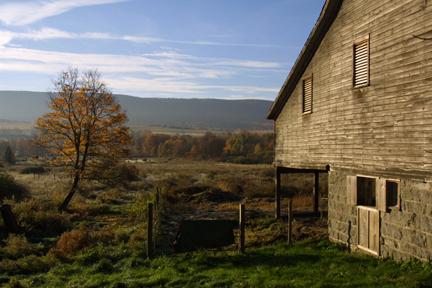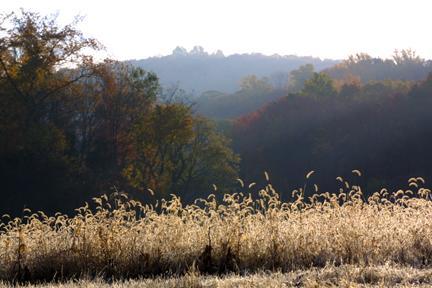Cherry Creek
Watershed
The Nature Conservancy and Cherry Valley
 The Nature Conservancy began taking an interest in the valley in 1999, and they have had scientists complete an on-the-ground inventory of rare plants and animals found here. One of the rare species uncovered is the small aquatic buttercup that occurs in Cherry Creek. The buttercup looks like seaweed in the water and prefers clean streams in limestone valleys. Another plant on the Pennsylvania list of rare species found here is grass-of- Parnassus as well as many others, more fully described below. Limestone wetlands or fens also are present in Cherry Valley, as well.
The Nature Conservancy began taking an interest in the valley in 1999, and they have had scientists complete an on-the-ground inventory of rare plants and animals found here. One of the rare species uncovered is the small aquatic buttercup that occurs in Cherry Creek. The buttercup looks like seaweed in the water and prefers clean streams in limestone valleys. Another plant on the Pennsylvania list of rare species found here is grass-of- Parnassus as well as many others, more fully described below. Limestone wetlands or fens also are present in Cherry Valley, as well.
The Nature Conservancy is active in its effort to create a farmland preservation plan for Cherry Valley. The May 26, 2001 issue of the Pocono Record contained an announcement that The Nature Conservancy had secured options to purchase two properties in the valley, including the 285-acre Blakeslee Farm. In addition to the farm owned by Mr. and Mrs. Jerome S. Blakeslee Jr., Mr. And Mrs. Howard Blakeslee and Mrs. Dorothea Blakeslee, the conservancy also secured the option to buy a 45-acre tract, with more than 2,000 feet fronting on the creek, from Mr. and Mrs. Frank Domotor.
The Conservancy had one year from that time to produce the $2 million needed: $1 million for the Blakeslee property, $425,000 for the Domotor property, and an estimated $575,000 for a long-term management endowment plus expenses of surveys and appraisals.
The Nature Conservancy View
 Highlights of a Presentation by Michael Pressman, Field Representative, at the September 20, 2001 Brodhead Watershed Association Annual Membership Meeting/Celebration
Highlights of a Presentation by Michael Pressman, Field Representative, at the September 20, 2001 Brodhead Watershed Association Annual Membership Meeting/CelebrationCherry Valley was formed as a result of glaciers, glacial lakes and lake bottom sediment. Some has said that the mud in the valley is as much as 80 feet deep in some spots. The resultant numerous, high-yield springs throughout the valley helps create and maintain a unique system of wetlands. Limestone rock provides a high pH parent material that produces soils supporting a diversity of special plants and natural communities.
According to the Nature Conservancy, at least ten rare plant species exist in the Valley including:
- Carex bebbli, Bebb’s sedge
- Carex flava, yellow sedge
- Conioselimum chinense, hemlock-parsley
- Epilobium strictur, downy willow-herb
- Eriophorum viridicarinatum, thin leaved cotton-grass
- Lobelia kalmii, brook lobelia
- Parnassia glauca, grass-of-Parnassus
- Ranunculus trichophyllus, water-crowfood
- Hillside graminoid fen
- And, Troillius laxus. Spreading globeflower.
Cherry Valley is part of a major raptor flyway along Blue Mountain’s Kittatinny Ridge), and spectacular views of Cherry Valley are seen from Wolf’s Rock, one of the most scenic parts of the entire Appalachian Trail.
Among the conservation challenges in the valley are:
- Inventorying, protecting, monitoring, managing and restoring the composition, structure and function of the system of wetlands
- Eliminating invasive plant species such as purple loosestrife, phragmites and Japanese knotweed
- Ensuring that growth and development are compatible with the Valley’s special features and that this does not result in excessive ground water withdrawal
- Documenting, monitoring and improving the quality of Cherry Creek
- Preserving the feel and beauty of the Valley
- Providing an environment that supports local businesses in the valley - Cherry Valley Vineyards, the apiary, the trout hatchery
- Helping local farmers to be profitable while assisting them with sound conservation practices that protect the soil, water, wetland and wildlife resources
- Helping local landowners implement conservation strategies that preserve, restore the Valley’s unique natural features while also meeting landowners’ financial needs
- And, providing targeted opportunities to allow people to explore, learn about, and appreciate the resources of the valley without compromising the integrity of these extra sensitive resources and maintaining the privacy of local landowners.
